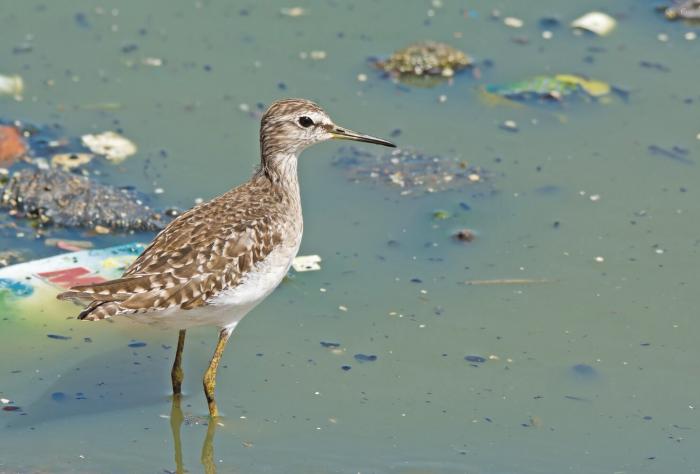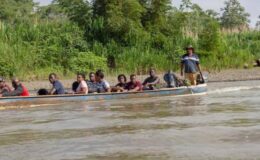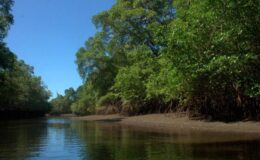River pollution remains threat to the Panama coastline.
- By : James Bryson
- Category : Environmental, Human Interest

Anyone flying into Tocumen from anywhere can see the brown and gray water that make up the “bay” that is supposed to be so vital to Panama tourism. The fact is outside of areas like Bocas and Contadora, the real beauty of Panama is missed by the massive failure of infrastructure to keep up with the last 20 years of skyline growth. 2022 needs to be a year where Mi Ambiente steps up to the challenge.
Jairo Escobar, consultant for the Natural Resources and Infrastructure Division of the Economic Commission for Latin America (ECLAC), prepared the document ‘The pollution of rivers and its effects on coastal areas and the sea’ and in this document reviewed by Axel Dourojeanni and Andrei Jouravlev, indicate that the pollution that reaches the sea does so through rivers and through coastal runoff, which produces effects that greatly impact estuaries and living resources.
Because of this, at the first United Nations Conference on Environment and Development, held in Rio de Janeiro in 1992, the international community adopted the integrated environmental management approach and committed to both integrated and sustainable management of and to promote watershed management practices to prevent, control and reduce the degradation of the marine environment.
The United Nations indicates that pollution of the marine environment is understood as “the introduction by man, directly or indirectly, of substances or energy into the marine environment, including estuaries, that produces or may produce harmful effects such as damage to living resources and marine life, dangers to human health, obstruction of maritime activities, including fishing and other legitimate uses of the sea, deterioration of the quality of sea water for its use and impairment of recreational areas.
An estuary is by definition of the Royal Academy of the Spanish Language, the mouth of a mighty river in the sea, characterized by having a shape similar to the longitudinal cut of a funnel, whose sides are moving away in the direction of the current, and by the influence of the tides in the union of fluvial waters with maritime ones.

The United Nations refers that pollution from hydrographic basins is considered conceptually as the source that pollutes estuaries.
Over the years and due to the growth of pollution in the oceans, the concept of marine pollution has been expanded to include factors of degradation of coastal strips and the marine environment, so that land-based sources can be included and differentiated. of marine pollution.
When land-based sources of marine pollution are indicated, ECLAC refers to point and diffuse sources, that is, direct or indirect pollution, which contribute to the pollution of the oceans and the pollutants that are transported by rivers, estuaries, canals and other watercourses, including seepage into the sea from surface and underground flows as well as wastewater discharges from septic tanks, submarine outfalls or defective treatment plants.
In addition, the sources of pollution generated by sedimentation resulting from erosion and land use practices within the basin and in coastal areas are considered, with special emphasis on mining tailings discharged into rivers and dumped into landfills. oceans.

Why are coastal zones important?
Coastal fringes are the areas where rivers flow and groundwater outcrops before joining the sea. It is in these areas where there are ecosystems made up of wetlands, coastal lagoons, marshes, mangroves, wetlands, freshwater habitats, estuaries. and riparian zones, whose interconnection promotes the exchange of nutrients with fresh water, dissolved solids, particles and living resources from the continents, creating habitats for various species and generating the ecosystem value of coastal zones.
ecosystem functions
Each ecosystem service is associated with an ecosystem function, thus, when mentioning them, the ecosystem service is indicated first and then its associated function.
In this way, the nutrient cycle is associated with the storage and processing of nutrients for the fixation of nitrogen and phosphorus; waste treatment is associated with the removal and reduction of excess nutrients and pollutants; The regulation of alterations is associated with the cushioning of the impact produced by climatic alterations such as the rise in sea level, which allows protection in coastal areas from the impacts of storms, floods and support in the recovery from droughts.
The food ecosystem service is associated with extractable primary productivity such as food that is associated with coastal aquaculture. The refuge is associated with the generation of habitat and the protection of the biodiversity of migratory species, among others.
The services provided by coastal aquatic ecosystems have been accounted for globally, based on the estimated cost of reproducing them in an “artificial biosphere” at $11.4 trillion.
Pollution management in coastal areas
About half of the world’s population is located less than 60 kilometers from the coast, and is affected by its own economic and industrial activities, since the pollution caused by anthropogenic activities impacts the health of ecosystems.
An example of this is the one indicated in the ECLAC document, where it is mentioned that untreated water, called sewage water, coming from San Miguelito, Tocumen, Arraiján and La Chorrera is introduced into the Bay of Panama through the Matasnillo and Matasnillo rivers. Juan Díaz, Aguacate and Caimito, and for this reason there are sampling points that mark the existence of total and fecal coliforms in the waters and some beaches of the Bay of Panama.
Part of the solution to the consequences of pollution in coastal marine areas is the application of water management by basins, since, from this approach, the quality of water and the protection of ecosystems are managed as essential elements in the management of the basin, thus allowing pollution control.
Pollution control towards coastal areas requires that soil and water management be integrated and that they be managed considering the activities of all users of the basin.
By establishing pollution controls in accordance with the uses of water in the basin, it is controlled that in the flood plains when the transport and temporary storage of pollutants and sediments occur, which will later be deposited in the sea, these are within the limits acceptable that do not cause environmental impacts on ecosystems.
challenges
One of the challenges is to understand the coastal marine ecosystem, so that pollution generated hundreds of kilometers away from the point of discharge can be identified for control.
Pollution control requires constant monitoring and the collaboration of the local and regional authorities of the institutions, such as the Ministry of Environment (MiAmbiente), the Ministry of Health (Minsa) and the universities that receive funds from the contests of research through the calls of the National Secretary of Science, Technology and Innovation (Senacyt).
Through these investigations, Panama has gained scientific knowledge for decision-making that guarantees the protection of coastal marine areas.



No Comments